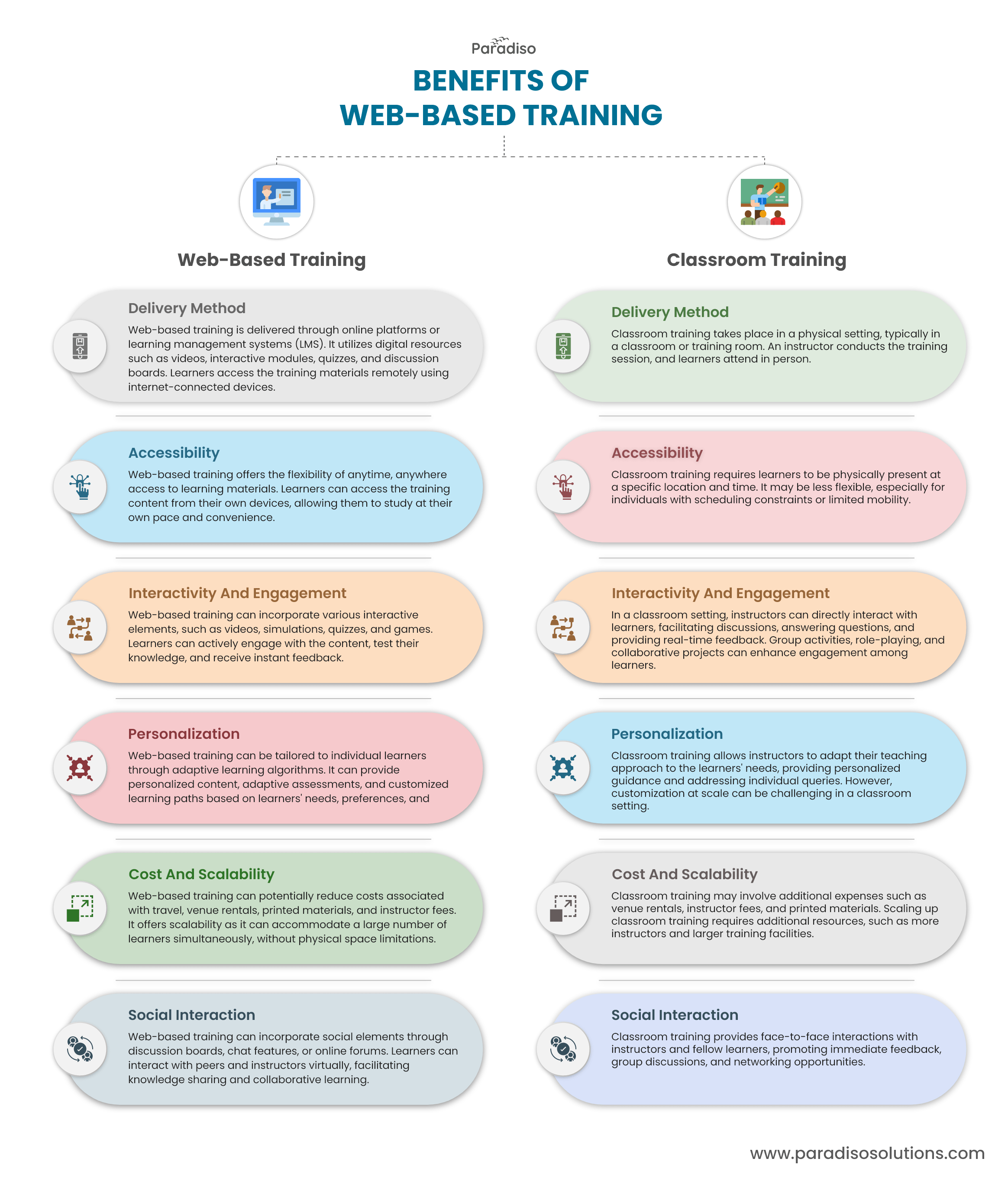In the age of rapidly advancing technology, the world of education and training has undergone a remarkable transformation. Gone are the days when classrooms were the sole domain of learning, as web-based training has emerged as a formidable contender.
Web based training vs. Classroom Training – Which is Better and Why?

Imagine a scenario where you can learn complex skills while lounging in your pajamas or absorb knowledge from renowned experts without being limited by geographical boundaries. The clash between web-based training and traditional classroom training is nothing short of an educational revolution, each vying for the title of the superior learning method.
So, let’s dive into this captivating debate and unravel the intricacies of these contrasting approaches to discover which one holds the key to unlocking the ultimate learning experience.
Web Based Training vs. Classroom Training: Basic Difference Explained
Web-based training (WBT), also known as online or e-learning, refers to the delivery of educational content and resources through web-based platforms. Learners can access training materials using their computers, tablets, or smartphones, and engage in self-paced learning. WBT offers a wide range of interactive tools such as videos, quizzes, simulations, and discussion boards, which facilitate learner engagement and knowledge retention. It provides the flexibility of accessing training materials at any time and from any location with an internet connection, making it convenient for individuals with busy schedules or those who prefer to learn at their own pace. WBT is particularly effective for subjects that require visual demonstrations, multimedia resources, or remote collaboration.
Experience the Future of Learning with Paradiso’s Web-based Training Solutions. Unleash Your Potential Today
On the other hand, classroom training also referred to as instructor-led training (ILT), takes place in a physical setting with a trained instructor leading the learning process. It involves face-to-face interactions between the instructor and learners, as well as among the learners themselves. Classroom training offers a structured and organized learning environment where learners can receive immediate feedback, ask questions, participate in discussions, and engage in group activities. This method allows for a more personal and interactive learning experience, fostering collaboration, teamwork, and the development of interpersonal skills. Classroom training is often preferred for subjects that require hands-on practice, real-time demonstrations, and dynamic discussions.
Both web-based training and classroom training have their own unique characteristics and advantages, providing learners with different learning experiences depending on their preferences and needs.
Exploring the Benefits of Web-Based Training over Classroom Training

Web-based training (WBT) offers several benefits over traditional classroom training. Here are a few key advantages:
-
Flexibility and Convenience:
WBT allows learners to access training materials at their own convenience, enabling them to learn at their own pace and fit their learning around their schedule. There are no fixed class timings or geographical constraints, making it ideal for individuals with busy lifestyles or those in remote locations.
-
Cost-Effectiveness:
Web-based training eliminates the need for travel expenses, accommodation, and venue costs associated with classroom training. Learners can access the training materials online, reducing overall training expenses for both individuals and organizations.
-
Access to a Wide Range of Resources:
WBT leverages multimedia tools such as videos, interactive quizzes, simulations, and online resources, providing learners with a rich and diverse learning experience. They can explore different formats and engage with interactive content that enhances understanding and retention.
-
Self-Paced Learning:
WBT allows learners to progress through the material at their own speed, catering to individual learning preferences and abilities. They can review and revisit the content as needed, ensuring a deeper understanding of the subject matter.
-
Global Reach and Collaboration:
With web-based training, learners can connect with instructors and peers from around the world. This opens opportunities for diverse perspectives, cross-cultural interactions, and collaboration on a global scale.
-
Scalability and Consistency:
WBT enables the delivery of training to large numbers of learners simultaneously, ensuring consistency in content and messaging. It is easily scalable to accommodate a growing number of participants without compromising the quality of the learning experience.
Conclusion
Web-based training holds significant advantages over classroom training, offering flexibility, convenience, cost-effectiveness, access to a wide range of resources, self-paced learning, global reach, and scalability. While classroom training may still have its place for certain subjects, the benefits of web-based training make it a compelling choice for learners seeking a personalized and accessible learning experience in today’s digital age.












